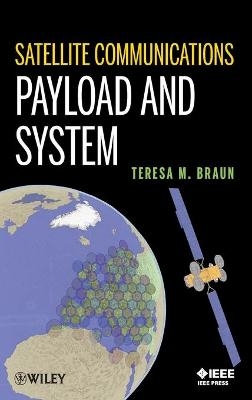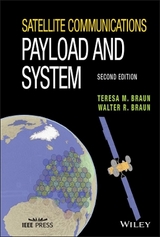
Satellite Communications Payload and System
John Wiley & Sons Inc (Verlag)
978-0-470-54084-8 (ISBN)
- Titel erscheint in neuer Auflage
- Artikel merken
Atmospheric effects and interference on the communications link are described. A chapter gives an example of optimizing a multibeam payload via probabilistic analysis. Finally, practical tips on system simulation and emulation are provided. The carrier frequencies treated are 1 GHz and above. Familiarity with Fourier analysis will enhance understanding of some topics. References are provided throughout the book for readers who want to dig deeper. Payload systems engineers, payload proposal writers, satellite-communications systems designers and analysts, and satellite customers will find that the book cuts their learning time. Spacecraft-bus systems engineers, payload unit engineers, and spacecraft operators will gain insight into the overall system. Students in systems engineering, microwave engineering, communications theory, probability theory, and communications simulation and modelling will find examples to supplement theoretical texts.
TERESA M. BRAUN, PhD, is President of Braun Communications Consulting GmbH. She has twenty-six years' experience in satellite and ground systems and technology, twenty-three in communications, and three in navigation, at major corporations. She earned her PhD at UCLA in electrical engineering in 1989.
PREFACE xix ACKNOWLEDGMENTS xxi ABOUT THE AUTHOR xxiii ABBREVIATIONS xxv 1 INTRODUCTION 1 1.1 What This Book Is About 1 1.2 Payload 3 1.3 Conventions 6 1.4 Book Sources 7 1.5 Summary of Rest of the Book 7 PART I PAYLOAD 2 PAYLOAD'S ON-ORBIT ENVIRONMENT 13 2.1 What Determines Environment 13 2.2 On-Orbit Environment 20 2.3 General Effects of Environment on Payload 27 3 ANTENNA 33 3.1 Introduction 33 3.2 General Antenna Concepts 35 3.3 Single-Beam Reflector Antenna 48 3.4 Horn 54 3.5 Antenna Array 57 3.6 Reflector-Based Multibeam Antenna 64 3.7 Autotrack 68 4 FILTER AND PAYLOAD-INTEGRATION ELEMENTS 79 4.1 Introduction 79 4.2 Impedance Mismatch 80 4.3 RF Lines for Payload Integration 82 4.3.1 Coaxial Cable 83 4.4 Other Payload-Integration Elements Aside from Switch 94 4.5 Filter 97 4.6 Switch and Redundancy 111 5 LOW-NOISE AMPLIFIER AND FREQUENCY CONVERTER 123 5.1 Introduction 123 5.2 Low-Noise Amplifiers and Frequency Converters in Payload 124 5.3 Intermodulation Products 126 5.4 Low-Noise Amplifier 127 5.4.1 LNA Unit Architecture and Technology 127 5.5 Frequency Converter 132 6 PREAMPLIFIER AND HIGH-POWER AMPLIFIER 147 6.1 Introduction 147 6.2 High-Power Amplifier Concepts and Terms 148 6.3 Traveling-Wave Tube Amplifier versus Solid-State Power Amplifier 153 6.4 Traveling-Wave Tube Amplifier Subsystem 155 6.5 Solid-State Power Amplifier 170 7 PAYLOAD'S COMMUNICATIONS PARAMETERS 181 7.1 Introduction 181 7.2 Gain Variation with Frequency 184 7.3 Phase Variation with Frequency 187 7.4 Channel Bandwidth 189 7.5 Phase Noise 190 7.6 Frequency Stability 190 7.7 Spurious Signals from Frequency Converter 191 7.8 High-Power Amplifier Nonlinearity 192 7.9 Spurious Signals from High-Power Amplifier Subsystem 192 7.10 Stability of Gain and Power-Out of High-Power Amplifier Subsystem 194 7.11 Equivalent Isotropically Radiated Power 195 7.12 Figure of Merit G/Ts 196 7.13 Self-Interference 199 7.14 Passive Intermodulation Products 201 8 MORE ANALYSES FOR PAYLOAD DEVELOPMENT 207 8.1 Introduction 207 8.2 How to Deal with Noise Figure 208 8.3 How to Make and Maintain Payload Performance Budgets 211 8.4 High-Power Amplifier Topics 223 8.5 How to Avoid Monte Carlo Simulations on Gaussian Random Variables 231 9 PROCESSING PAYLOAD 241 9.1 Introduction 241 9.2 Capabilities of Current Processing Payloads 242 9.3 Digital-Processing Elements Common to Both Nonregenerative and Regenerative Payloads 245 9.4 Nonregenerative Processing-Payload 248 9.5 Regenerative Payload 250 PART II PAYLOAD IN END-TO-END COMMUNICATIONS SYSTEM 10 PRINCIPLES OF DIGITAL COMMUNICATIONS THEORY 259 10.1 Introduction 259 10.2 Communications Theory Fundamentals 260 10.3 Modulating Transmitter 268 10.4 Filters 278 10.5 Demodulating Receiver 281 10.6 SNR, Es/N0, and Eb/N0 293 10.7 Summary of Signal Distortion Sources 295 11 COMMUNICATIONS LINK 299 11.1 Introduction 299 11.2 End-to-End C/N0 300 11.3 Signal Power on Link 301 11.4 Noise Level on Link 311 11.5 Interference on Link 312 11.6 Link Budget 317 12 PROBABILISTIC TREATMENT OF MULTIBEAM DOWNLINKS 321 12.1 Introduction 321 12.2 Multibeam-Downlink Payload Specifications 322 12.3 Repeater-Caused Variation of C and C/Iself and Nominal Value 324 12.4 Combining Antenna-Caused Variation into Repeater-Caused Variation 333 12.5 Payload-Caused Variation of CI(I+N) 337 12.6 Combining Atmosphere-Caused Variation into Payload-Caused Variation 337 12.7 Optimizing Multibeam-Downlink Payload Specified on Link Availability 339 13 END-TO-END COMMUNICATIONS SYSTEM MODEL WITH FOCUS ON PAYLOAD 343 13.1 Introduction 343 13.2 Considerations for Both Software Simulation and Hardware Emulation 344 13.3 Additional Considerations for Simulation 352 13.4 Additional Considerations for Emulation 359 References 362 INDEX 363
| Erscheint lt. Verlag | 2.10.2012 |
|---|---|
| Reihe/Serie | Wiley - IEEE ; 1 |
| Verlagsort | New York |
| Sprache | englisch |
| Maße | 158 x 252 mm |
| Gewicht | 736 g |
| Themenwelt | Technik ► Elektrotechnik / Energietechnik |
| Technik ► Nachrichtentechnik | |
| ISBN-10 | 0-470-54084-2 / 0470540842 |
| ISBN-13 | 978-0-470-54084-8 / 9780470540848 |
| Zustand | Neuware |
| Haben Sie eine Frage zum Produkt? |
aus dem Bereich



